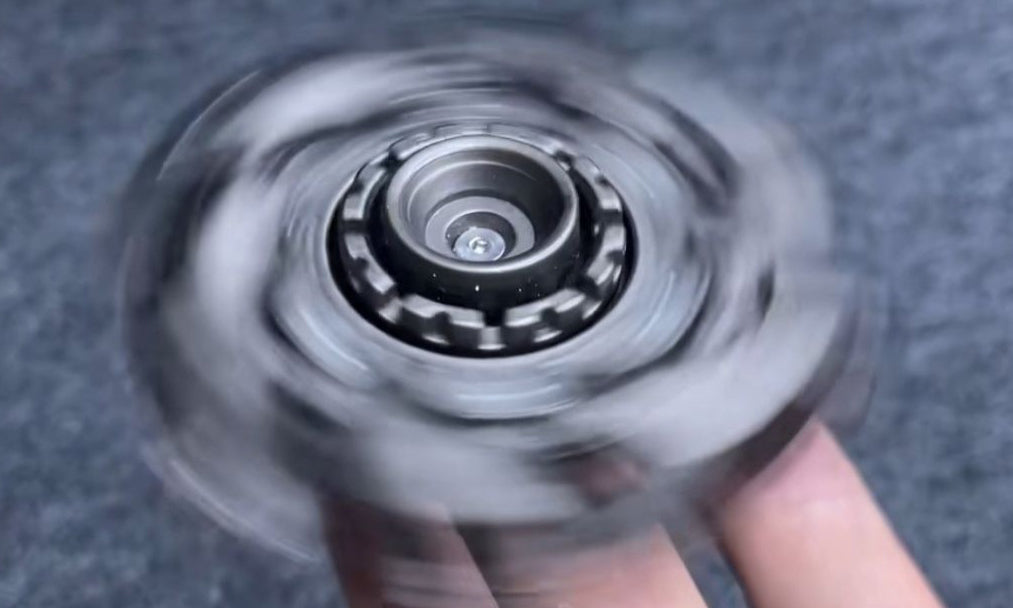
The Ultimate Guide to Fidget Spinners: From Stress Relief to Collectible Art
Share
Remember the global fidget spinner craze of 2017? It seemed like everyone was spinning these little devices in their hands. While the hype has subsided, fidget spinners have evolved from simple stress-relief toys into sophisticated collectibles, art pieces, and even a lifestyle. Whether you're looking for a stress management tool, fascinated by precision mechanics, or want to collect beautiful objects, fidget spinners offer a unique experience.
The Origin and Evolution of Fidget Spinners
The inventor of the fidget spinner is Catherine Hettinger, a chemical engineer. In 1993, to keep her daughter quiet in church, she created the first simple fidget spinner using printer parts and bearings. Unfortunately, she failed to pay the patent maintenance fee on time, resulting in the patent expiring in 2005.
In 2017, fidget spinners suddenly became a global phenomenon. Initially marketed as tools to help people with ADHD and anxiety disorders focus, they quickly became popular stress-relief toys for the general public. At the peak of the craze, some limited edition and high-quality fidget spinners were even resold for thousands of dollars.
Today, fidget spinners have developed into a mature niche market with numerous specialized brands and passionate enthusiast communities. From plastic toys costing a few dollars to handmade custom artworks worth thousands, this small spinning device has evolved into various forms.
Core Structure and Working Mechanism
Bearing System
The bearing is the heart of a fidget spinner, directly determining its spinning performance and user experience. Common bearing types include:
Stainless Steel Bearings: Most common type, cost-effective, good corrosion resistance, but require regular cleaning and maintenance.
Ceramic Bearings: Smoother spin, more durable, rust-proof, but more expensive. Available in full ceramic and hybrid ceramic versions.
Titanium Bearings: Lightweight, high strength, corrosion resistant, preferred for high-end spinners.
Spinner Body Design
Weight Distribution: Excellent design requires balanced weight distribution, which directly affects spinning stability and hand feel.
Material Selection: Ranges from common aluminum alloy and stainless steel to premium materials like titanium, copper, and even precious metals and exotic materials.
Surface Treatment: Various processes including anodizing, sandblasting, polishing, and engraving affect appearance and hand feel.
Materials and Craftsmanship
Common Material Characteristics
Aluminum Alloy: Lightweight, easy to machine, low cost, but relatively low hardness.
Stainless Steel: Moderate weight, good durability, solid feel, but prone to fingerprints.
Copper: High density, heavy feel, develops unique patina over time, popular among collectors.
Titanium Alloy: High strength, lightweight, good biocompatibility, but difficult to machine and expensive.
Manufacturing Processes
CNC Machining: Computer numerical control machining offers high precision and can create complex designs.
Hand Polishing: High-end products often feature hand polishing to ensure perfect surface treatment.
Special Techniques: Including special materials and processes like Damascus steel, Mokume-gane, etc.
How to Choose the Right Fidget Spinner
Based on Usage Purpose
Daily Stress Relief: Choose moderately weighted, portable, and reasonably priced models.
Collection Appreciation: Focus on design uniqueness, material craftsmanship, and limited edition products.
Skill Practice: Select models with good balance and stable spinning.
Important Considerations
Weight: Typically between 50-150 grams, each weight has its characteristics
Size: Consider hand size and portability
Spin Time: Good spinners can spin for 3-8 minutes
Hand Feel: Edge treatment, weight distribution, and other factors affecting hand feel
Price Range: From tens to thousands of dollars, choose according to budget
Usage Techniques and Tricks
Basic Spinning Techniques
Single Finger Spin: Most basic spinning method using thumb and index finger
Finger Switching: Transfer spinning spinner between different fingers
Surface Spinning: Spinning performance on flat surfaces
Advanced Techniques
Hand Alternation: Complex spinning movements using both hands
Long Duration Spinning: Extending spin time through technique
Performance Tricks: Performance spinning combined with body movements
Maintenance and Care Guide
Regular Cleaning
Bearing Cleaning: Clean with specialized cleaner or anhydrous alcohol
Surface Maintenance: Use appropriate maintenance methods for different materials
Storage Considerations: Avoid impact and scratching, use dedicated storage boxes
Common Issue Solutions
Reduced Spin Time: Usually indicates need for bearing cleaning
Unusual Noise: Check for impurities or damage
Balance Issues: May be due to bearing installation or spinner body problems
Fidget Spinner Culture and Community
Fidget spinners have developed a unique cultural phenomenon. Online forums, social media groups, and offline gatherings allow enthusiasts to exchange experiences, showcase collections, and trade items. Some renowned designers and brands have large loyal followings, with new product releases often selling out quickly.
A collection culture has gradually formed, with limited numbering, special materials, and famous designs becoming important indicators of collection value. Some early limited edition spinners command high prices in the secondary market.
Future Development Trends
Technological Innovation
New Material Applications: Use of new alloys, composite materials, etc.
Smart Spinners: Incorporation of electronic components for counting, lighting, and other functions
Customization Services: Custom-made spinners according to personal preferences
Market Development
Premiumization: Development toward artwork-level collectibles
Mass Market: Continuous optimization of cost-effective products
Functionalization: Multi-functional products combining with other features
Conclusion
Fidget spinners have evolved from a temporary trendy toys into a collectible category with deep cultural heritage. Whether you're looking for a stress relief tool, starting a new collection journey, or simply appreciating the beauty of precision mechanics, fidget spinners can provide unique experiences and enjoyment.
In this digital age, a tangible mechanical device that spins at your fingertips might be exactly what we need—a small object that allows us to temporarily step away from screens and focus on the present moment.
Have you ever owned a fidget spinner? What materials and designs do you prefer? Share your fidget spinner stories in the comments below!